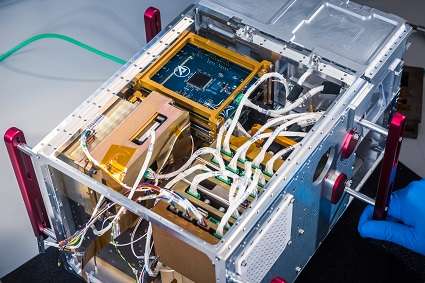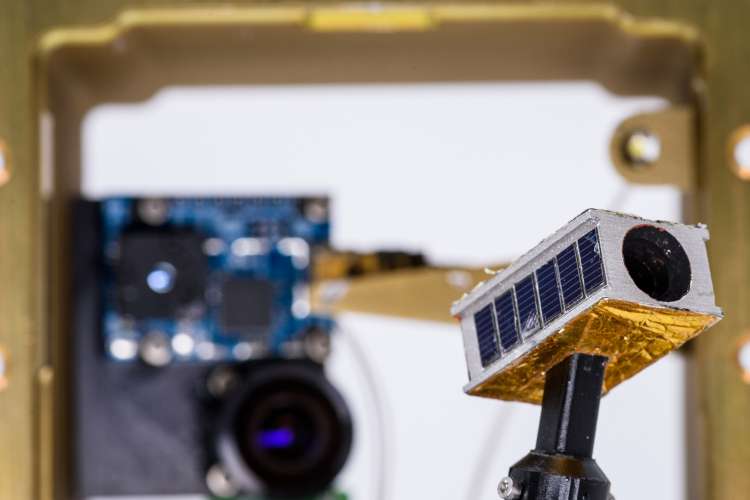
Space-based technology has become essential to modern society, and the accelerated pace of innovation continues to increase demand for space-based services. This has prompted a need for more resilient and responsive satellite development and launch processes that can streamline the mission lifecycle to reduce time and cost, while providing greater flexibility and adaptability for space access.
Recognizing the need for modernizing the space enterprise, The Aerospace Corporation has emphasized the adoption of Continuous Production Agility (CPA) principles, which leverages increased production and launch tempo rates, interoperability standards and open architecture to enable greater agility and resiliency for space systems.
A prime example of Aerospace efforts in this area is a program named Slingshot, which looks to advance on-orbit experiments using modular and autonomous technologies on next-generation satellite systems. In essence, Slingshot looks to simplify the architecture with open standards and plug-and-play interfaces to streamline bus-to-payload, satellite-to-satellite, and space-to-ground communications.
Advancing Modularity for the Future of Space
“There have been a lot of efforts to create standard interfaces in space. As is common in the tech world, a standard that satisfies everyone can end up satisfying no one, because the standard can get weighed down by a lot of requirements and things can get very complicated very quickly,” said Dr. Randy Villahermosa, general manager of Aerospace’s iLab. “With Slingshot, we’ve created an open standard interface where payloads plug together with a satellite, using a reduced number of requirements. This enables clients who want to get to space as quickly as possible to do so, without adding risk.”

Wider adoption of modular, open standards for spacecraft enables greater speed, flexibility and agility to meet the needs of a “launch-on-schedule” model.
Furthermore, a modular architecture could help to extend spacecraft lifespans by allowing for individual components to be more efficiently upgraded or replaced as needed.
Aerospace is building upon its own innovations in the area of modularity to advance the state-of-the-art.
For many years now, Aerospace has been flying new technologies for customers on its AeroCube CubeSat platform, and an early version of a simple standard interface helped accelerate many of these emerging technologies into space.
A New Standard for SmallSats
A key feature of the Slingshot platform is the use of SatCat5, an open source mixed-media ethernet switch architecture that enables a variety of devices to communicate on the same network. Unlike other existing standards, such as CAN and SpaceWire, SatCat5 is able to simultaneously provide high throughput and low-power consumption using ethernet technologies and an end-to-end payload development kit.
Slingshot also uses one common bus-to-payload interface, providing a reusable standard that can eliminate the ad-hoc proliferation of complex, dissimilar protocols that have historically bogged down connectivity and driven up costs.
“We’ve created an interface that’s comparable to connecting a thumb drive to your laptop,” said Dan Mabry, Mission Systems Engineer for the project. “Another benefit is that after the first unit, the development cost for the software is essentially zero for future units.”
Slingshot 1 Mission Readies for Launch

Slated for launch in 2022, the Slingshot 1 mission aims to prove the feasibility of providing a standard interface for multiple payloads on a single spacecraft flying in low Earth orbit. In addition to providing access to an on-orbit space test environment, the mission will demonstrate the capability of the SatCat5 ethernet standard, which would allow developers to employ commercial tools and open-source code from the extensive ethernet ecosystem.
“Now, when a payload plugs in it’ll instantly be recognized and work, and any broadcast data will get to the spacecraft downlink without any tuning or tweaking of the software onboard. Furthermore, because it’s an onboard network, that payload’s data is seen by all the other payloads as well,” said Mabry. “Payloads can easily collaborate in real-time, and distributed smart sensors and processors are coupled by the basic architecture. Eventually, as more capable processors become available you could pull the first processor out and plug the new one in, and it would work. And upgrades wouldn’t be a recurring cost.”
Enabling New Opportunities for Space
In a further bid for increased satellite autonomy, the Slingshot 1 mission will also test the functionality of:
- VERTIGO – A modular attitude control system prototype that can enable satellites to point at targets on earth.
- BLINKER – A GPS transponder for space traffic management.
- HYPER – A hydrogen peroxide thruster.
- LASERCOMM – A next-generation space/ground lasercom downlink.
The Slingshot 1 mission aims to demonstrate a model in which technologies can be deployed in a far more efficient and expedient manner to enable autonomous, on-orbit reconfigurability and dynamic satellite tasking. As new opportunities emerge in transforming the nation’s space systems architecture to be more efficient, agile and resilient, Aerospace’s unmatched technical expertise and role as a trusted partner make it uniquely suited to support its customers in shaping the future of space.

